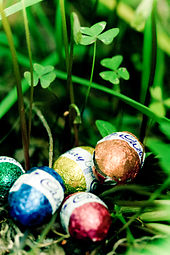Egg hunt

An egg hunt is a treasure hunt played at Easter during which children look for hidden decorated eggs or Easter eggs. Real hard-boiled eggs, which are typically dyed or painted, artificial eggs made of plastic filled with chocolate or candies, or foil-wrapped egg-shaped chocolates of various sizes are hidden in various places; as many people give up sweets as their Lenten sacrifice, individuals consume them after having abstained from them during the preceding forty days of Lent.[1]
The game is often played outdoors, but can also be played indoors. The children typically collect the eggs in a basket. When the hunt is over, prizes may be given out for various achievements, such as the largest number of eggs collected, for the largest or smallest egg, for the most eggs of a specific color, consolation prizes or booby prizes.[2] Real eggs may further be used in egg tapping contests. If eggs filled with confetti left from Mardi Gras (cascarones) are used, then an egg fight may follow.[2] Eggs are placed with varying degree of concealment, to accommodate children of varying ages and development levels. In South German folk traditions it was customary to add extra obstacles to the game by placing them into hard-to reach places among nettles or thorns.[3]
History

The egg was a symbol of the rebirth of the earth in pre-Christian celebrations of spring. However, the Easter egg itself was defined by early Christians as an Easter symbol of the resurrection of Jesus: the egg symbol was likened to the tomb from which Christ arose.[4] Lizette Larson-Miller, a professor with the Graduate Theological Union of Berkeley, traces the specific custom of the Easter egg hunt to the Protestant Christian Reformer Martin Luther, stating "We know that Martin Luther had Easter egg hunts where the men hid the eggs for the women and children, and it probably has this connection back to this idea of eggs being the tomb."[5] Easter egg hunts thus symbolized the search for the empty tomb and the risen Jesus.[6][7] At least since the 17th century the idea of the Easter Bunny to bring the Easter eggs has been known. The novelty of the introduction of Easter egg hunts into England is evidenced by A. E. Housman's inaugural lecture as Professor of Latin at University College, London in 1892, in which he said, "In Germany at Easter time they hide coloured eggs about the house and garden that the children may amuse themselves in discovering them."[8]

Reverend MaryJane Pierce Norton, Associate General Secretary of Leadership Ministries at the General Board of Discipleship, states that "there's something about going to hunt the eggs just as we might go to hunt for Jesus in the tomb. And when we find them it's that joy that the women had when they reached the tomb first and found that Jesus was no longer there."[9] Traditionally the game is associated with Easter and Easter eggs, but it has also been popular with spring time birthday parties.[2] Egg hunts are a subject of the Guinness Book of World Records; Homer, Georgia, United States was listed in 1985 with 80,000 eggs to hunt in a town of 950 people.
To enable children to take part in egg hunts despite visual impairment, eggs have been created that emit various clicks, beeps, noises, or music.[10]
Commercial use

A number of companies have made use of the popularity of Easter and more specifically Easter egg hunts to promote the sales of their candy products. Most notable have been chocolatiers including Cadbury with their annual Easter Egg Trail which takes place in over 250 National Trust locations in the UK.[11] In 2015, the British chocolate company Thorntons worked with the geocaching community to hide chocolate eggs across the United Kingdom.[12]
See also
References
- ^ Shoda, Richard W. (2014). Saint Alphonsus: Capuchins, Closures, and Continuity (1956-2011). Dorrance Publishing. p. 128. ISBN 978-1-4349-2948-8.
- ^ a b c "An April Birthday Party"[permanent dead link], by Margaret Remington, The Puritan, April–September 1900.
- ^ Venetia Newall (1971) An Egg at Easter: A Folklore Study, p. 323
- ^ "History of the Easter Egg" (PDF). Warwickshire County Council. Archived from the original (PDF) on 2008-06-29. Retrieved 2008-03-17.
- ^ Davis, David (20 April 2014). "What's with the bunny and the eggs? Easter traditions explained". CBS News. Retrieved 20 April 2014.
- ^ Hunt, Scott (15 March 2016). "What's Up with Eggs and Easter?". St. George's Anglican Church. Retrieved 10 April 2023.
The egg, with its hard shell, was used to represent Jesus' tomb. Outside it looks lifeless. But, after a time, from inside breaks out new life. In some traditions the eggs were painted red to represent the blood of Christ shed for us. Easter egg hunts were organized to represent searching out the risen Jesus. Egg rolling was a game to remember how the stone was rolled away from the entrance of Jesus' tomb. Even Martin Luther is said to have been a fan of Easter Eggs and Easter Egg hunts.
- ^ Rogers, Jennifer (14 March 2023). "Easter Eggs: What Is the History Behind This Tradition?". Chase Oaks Church. Retrieved 10 April 2023.
One of the earliest Easter egg hunts that most resembles the modern Easter egg hunt can be traced to Martin Luther. Martin Luther was a key leader in the Protestant Reformation. During this time, men would hide eggs for women and children to find. The joy the women and children experienced as they found eggs mirrored the joy the women felt when they found Jesus' tomb empty and realized He had risen.
- ^ A. E. Housman, Collected Poems and Selected Prose (Penguin Books, 1989), at page 274.
- ^ Glass, Laurens (2014). "The Importance of the Egg: Children and Easter". United Methodist Communications. The United Methodist Church. Archived from the original on 17 April 2014. Retrieved 16 April 2014.
- ^ Tillery, Carolyn (2008-03-15). "Annual Dallas Easter egg hunt for blind children scheduled for Thursday". The Dallas Morning News. Archived from the original on 2008-03-19. Retrieved 2008-03-27.
- ^ "Cadbury and National Trust accused of 'airbrushing faith' by Church of England for dropping 'Easter' from egg hunt". Independent.co.uk. The Independent. 4 April 2017. Retrieved 18 May 2019.
- ^ "Easter Egg Hunts". Thorntons. Archived from the original on 2016-04-05. Retrieved 2015-03-11.
